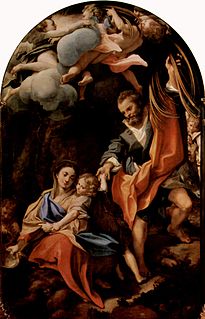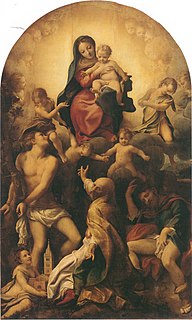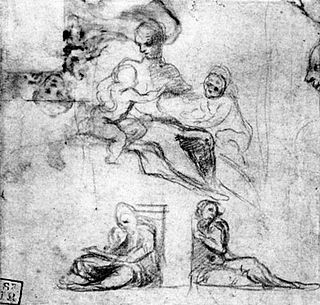
Antonio Allegri da Correggio, usually known as just Correggio, was the foremost painter of the Parma school of the High Italian Renaissance, who was responsible for some of the most vigorous and sensuous works of the sixteenth century. In his use of dynamic composition, illusionistic perspective and dramatic foreshortening, Correggio prefigured the Baroque art of the seventeenth century and the Rococo art of the eighteenth century. He is considered a master of chiaroscuro.

Lelio Orsi, also known as Lelio da Novellara, was a Mannerist painter and architect of the Reggio Emilia school in northern Italy.

Raffaele Motta, known as Raffaellino da Reggio, was an Italian Mannerist style painter from Reggio Emilia, who mainly worked in Rome. He assimilated the style of Taddeo Zuccari and also developed more personal traits. In the last three years of his short life, he worked alongside Lorenzo Sabbatini in works for the Vatican commissioned by Gregory XIII. The Late Mannerist painter and historian Giovanni Baglione considered Raffaellino's early death a significant loss to art.

The Galleria Estense is an art gallery in the heart of Modena, centred around the collection of the d’Este family: rulers of Modena, Ferrara and Reggio from 1289 to 1796. Located on the top floor of the Palazzo dei Musei, on the St. Augustine square, the museum showcases a vast array of works ranging from fresco and oil painting to marble, polychrome and terracotta sculpture; musical instruments; numismatics; curios and decorative antiques.

San Giovanni Evangelista is a church in Parma, northern Italy, part of a complex also including a Benedictine convent and grocery.

The Madonna of the Basket or the Madonna della Cesta is a painting of c. 1524 by Antonio da Correggio in the National Gallery, London. While it is a Mannerist painting of the Virgin Mary and the Baby Jesus, Correggio included naturalist touches in his composition, like the sewing basket that gives the painting its name.

Head of Christ is a painting in oil on panel by the Italian Renaissance painter Correggio, dated 1521. It depicts the head of Christ, wearing the crown of thorns. In the background there is a white cloth showing that the image represents the Veil of Veronica, but Christ's head is given volume through alternate use of light and dark shadows. The painting is in the J. Paul Getty Museum in Malibu, Los Angeles. Correggio was known for creating some of the most sumptuous religious paintings of the period. The Getty Museum considers this artwork as one of the masterpieces of painting held by the museum.

Madonna della Scodella is an oil painting on panel by Antonio da Correggio, dated from 1528 to about 1530 and preserved at the Galleria nazionale di Parma.

Saints Peter, Martha, Mary Magdalen and Leonard or Four Saints is a 1514 oil on canvas altarpiece by Correggio, now in the Metropolitan Museum of Art in New York City. He painted it for the church of Santa Maria della Misericordia and it shows Saint Peter, Saint Martha, Mary Magdalene and Leonard of Noblac.

The Bolognini Madonna is a 16th century oil on panel painting by Antonio da Correggio.

The Campori Madonna is an oil on panel painting, attributed to the painter Vincenzo Rasori to Antonio da Correggio.

The Allegory of Vice is an oil on canvas painting by Correggio dating to around 1531 and measuring 149 by 88 cm.

The San Sebastiano Madonna is an oil on canvas painting by Correggio, dating to around 1524 and now in the Gemäldegalerie Alte Meister in Dresden. It measures 265 by 161 cm.

The Casalmaggiore Madonna is a lost oil on canvas painting by Correggio, measuring 28 by 24 cm and painted around 1522.

The Holy Family with Saint Jerome is a 68 by 56 cm oil on poplar panel painting by Correggio. It dates to around 1515 and is now displayed in the East Closet of Hampton Court Palace as part of the Royal Collection. It has similarities with the Holy Family with the Infant Saint John the Baptist and so it probably dates to around the time Correggio painted the frescoes in the Camera di San Paolo or possibly slightly earlier. It shows the Holy Family and saint Jerome.

Madonna and Child with Saint George is an oil on panel painting by Correggio dating to around 1530 and now in the Gemäldegalerie in Dresden.

The Madonna of the Stairs is a fresco fragment by Correggio, dating to around 1522-1523 and now in the Galleria Nazionale di Parma.

La Zingarella is a 49 x 37 cm oil on panel painting by Correggio dating to around 1516-1517. It shows the Rest on the Flight into Egypt, although it omits the figure of Saint Joseph. It is now in the Museo Nazionale di Capodimonte in Naples.

Agony in the Garden is a small 1524 oil on panel painting of the Agony in the Garden by Correggio, now at Apsley House in London.

Saint Joseph and a Devotee is a 1529 tempera on canvas painting on two panels by Correggio, an attribution first proven in the modern era by Ferdinando Bologna in 1957. The panels are mentioned in the 1680 inventories of the Palazzo del Giardino in Parma as a work by Correggio. It is also recorded as such in Giacomo Barri's Viaggio pittoresco, published in 1671. Until the end of the 18th century it featured in Farnese inventories as a work by Corregio. It was probably moved to Naples with the rest of the Farnese collection in 1734 and is now in the National Museum of Capodimonte there.




















